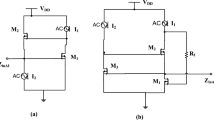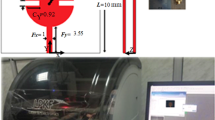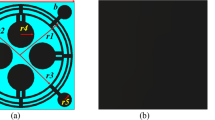Abstract
Analysis and design of a low-noise transconductance amplifier (LNTA) aimed at selective current-mode (SAW-less) wideband receiver front-end is presented. The proposed LNTA uses double cross-coupling technique to reduce noise figure (NF), complementary derivative superposition, and resistive feedback to achieve high linearity and enhance input matching. The analysis of both NF and IIP3 using Volterra series is described in detail and verified by SpectreRF ® circuit simulation showing NF < 2 dB and IIP3 = 18 dBm at 3 GHz. The amplifier performance is demonstrated in a two-stage highly selective receiver front-end implemented in 65 nm CMOS technology. In measurements the front-end achieves blocker rejection competitive to SAW filters with noise figure 3.2–5.2 dB, out of band IIP3 >+17 dBm and blocker P1dB >+5 dBm over frequency range of 0.5–3 GHz.
















Similar content being viewed by others
References
Ru, Z., et al. (2009). Digitally enhanced software-defined radio receiver robust to out-of-band interference. Journal of Solid-State Circuits, 44(12), 3359–3375.
Yu, C. Y., et al. (2011). A SAW-less GSM/GPRS/EDGE receiver embedded in 65-nm SoC. IEEE Journal of Solid-State Circuits, 46(12), 3047–4060.
Mirzaei, A., et al. (2011). A 65 nm CMOS quad-band SAW-less receiver SoC for GSM/GPRS/EDGE. IEEE Journal of Solid-State Circuits, 46(4), 946–950.
Murphy, D., Darabi, H., et al. (2012). A blocker-tolerant, noise-cancelling receiver suitable for wideband wireless applications. IEEE Journal of Solid-State Circuits, 47(12), 2943–2963.
Kim, J., & Silva-Martinez, J. (2013). Low-power, low-cost CMOS direct-conversion receiver front-end for multistandard applications. IEEE Journal of Solid-State Circuits, 48(9), 2090–2103.
Fabiano, I., et al. (2013). SAW-less analog front-end receivers for TDD and FDD. IEEE Journal of Solid-State Circuits, 48(12), 3067–3079.
Qazi, F., et al. (2015). Two-stage highly selective receiver front-end based on impedance transformation filtering. IEEE Transactions on Circuit and Systems II, 62(5), 421–425.
Franks, L. E., & Sandberg, I. W. (1960). An alternative approach to the realization of network transfer functions: The N-path filter. Bell System Technical Journal, 39(5), 1321–1350.
Zhang, H., & Sanchez-Sinencio, E. (2011). Linearization techniques for CMOS low noise amplifiers: A tutorial. Transactions on Circuit and Systems, 58(1), 22–36.
Aparin, V., et al. (2004). Linearization of CMOS LNAs via optimum gate biasing. Proceedings of IEEE International Conference on Circuits and Systems, IV, 748–751.
Kim, T. W., Kim, B., & Lee, K. (2004). Highly linear receiver front-end adopting MOSFET transconductance linearization by multiple gated transistors. Journal of Solid-State Circuits, 39(1), 223–229.
Aparin, V., et al. (2005). Modified derivative suprposition method for linearizing FET low-noise amplifiers. IEEE Transactions on Microwave Theory Techniques, 53(2), 571–581.
Im, D., et al. (2009). A wideband CMOS low noise amplifier employing noise and IM2 distortion cancellation for a digital TV tuner. Journal of Solid-State Circuits, 44(3), 686–698.
Geddada, H. M., et al. (2014). Wide-band inductorless low-noise trans-conductance amplifiers with high large-signal linearity. IEEE Transactions on Microwave Theory and Techniques, 62(7), 1495–1505.
Duong, Q.-T., & Dąbrowski, J. (2011). Low noise transconductance amplifier design for continuous-time delta sigma wideband front-end. European Conference on Circuit Theory and Design (ECCTD), 3, 825–828.
Zhang, H., et al. (2009). A low-power, linearized, ultra-wideband LNA design technique. Journal of Solid-State Circuits, 44(2), 320–330.
Woo, S., et al. (2009). A 3.6 mW differential common-gate CMOS LNA with positive-negative feedback. IEEE International Solid-State Circuits Conference—Digest of Technical Papers, ISSCC, 2009, 218–219.
Kim, J., et al. (2010). Wideband common-gate CMOS LNA employing dual negative feedback with simultaneous noise, gain, and bandwidth optimization. IEEE Transactions on Microwave Theory and Techniques, 58(9), 2340–2351.
Bruccoleri, F., et al. (2004). Wide-band CMOS low-noise amplifier exploiting thermal noise canceling. Journal of Solid-State Circuits, 39(2), 275–282.
Zhuo, W., et al. (2000). Using capacitive cross-coupling technique in RF low noise amplifier and down-conversion mixer design. European Solid-State Circuits Conference, ESSCIRC, 3, 77–80.
Reiha, M., & Long, J. (2007). A 1.2 V reactive-feedback 3.1–10.6 GHz low-noise amplifier in 0.13 μm CMOS. Journal of Solid State Circuits, 42(5), 1023–1033.
Chen, W.-H., et al. (2008). A highly linear broadband CMOS LNA employing noise and distortion cancellation. Journal of Solid-State Circuits, 43(5), 1164–1176.
Blaakmeer, S. C., et al. (2008). Wideband balun-LNA with simultaneous output balancing, noise-canceling and distortion-canceling. Journal of Solid-State Circuits, 43(6), 1341–1350.
Ahsan, N. et al. (2008). Highly linear wideband low power current mode LNA. International Conference on Systems and Electronic Systems, ICSES. doi:10.1109/ICSES.2008.4673361
Amer, A., et al. (2007). A 90-nm wideband merged CMOS LNA and mixer exploiting noise cancellation. Journal of Solid-State Circuits, 42(2), 323–328.
Mehrpoo, M., & Staszewski, R. B. (2013). A highly selective LNTA capable of large-signal handling for RF receiver front-ends. In Proceedings of IEEE RFIC symposium (pp. 185–188).
Zhang, L., et al. (2015). Analysis and design of a 0.6–10.5 GHz LNTA for wideband receivers. Transactions On Circuits and Systems II, Express Briefs, 62(5), 431–435.
Mirzaei, A., et al. (2011). A low-power process-scalable super-heterodyne receiver with integrated high-Q filters. Journal of Solid-State Circuits, 46(12), 2920–2932.
Darvishi, M., et al. (2013). Design of active N-path filters. Journal of Solid-State Circuits, 48(12), 2962–2976.
Author information
Authors and Affiliations
Corresponding author
Appendices
Appendix 1: Derivation of the Volterra operators for the proposed LNTA: G1, G2 and G3
For the circuit shown in Fig. 9 the respective currents and voltages can be expressed as
where
Substituting (22, 23) into (43, 44) with maximum 3rd order of v in , we have
where
Substituting (22, 23), (45, 51–55) into (46), we have
Appendix 2: Derivation of the Volterra operators for the proposed LNTA: A1, A2, A3, H1, H2 and H3
For the circuit of Fig. 9 the current and voltage equations follow
where
For differential mode, the single voltages should be
Rights and permissions
About this article
Cite this article
Duong, QT., Qazi, F. & Dąbrowski, J.J. Analysis and design of low noise transconductance amplifier for selective receiver front-end. Analog Integr Circ Sig Process 85, 361–372 (2015). https://doi.org/10.1007/s10470-015-0629-5
Received:
Revised:
Accepted:
Published:
Issue Date:
DOI: https://doi.org/10.1007/s10470-015-0629-5




